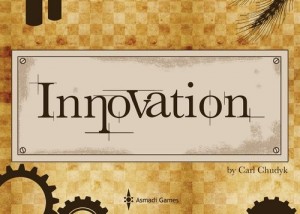 Innovation
Innovation
by Carl Chudyk
Asmadi Games, 2010
$25 Buy from Amazon or Asmadi Games or try online at Isotropic
Writing [Blue/Age 1/Bulb]: Draw a 2.
It doesn’t look like much on its own, but that small amount of information tells you everything you need to know about one of the most monumental achievements in human history. It’s just one example of 105 concepts and technologies represented in Carl Chudyk’s clever (and occasionally revelatory) minimalistic card game Innovation.
Of course, being as it is an exploration of the march of human progress from Prehistory through the Information Age, Innovation is minimalistic only on its surface. The goal of the game, reduced to its simplest format, is to harness these advancing concepts to steer your culture (represented by a tableau of cards in front of you) toward monumental achievements—specifically, more and faster achievements than the other players. Ideas from The Wheel to The Internet are represented by the intersection, on a single card, of four very simple elements: a color (one of five, which might be thought of as the card’s suit); a value (the age, 1-10, that the invention hails from); a “dogma” effect, which can be called upon once the card has been “melded,” or put into play; and three icons, of one or more of 8 types, arranged around the bottom-left borders of the card like a supine L.
In play, the clipart-style icons and mostly solid colors make Innovation redolent of a child’s educational toy. From the outside, that is. In play—that is, to those actually experiencing the game—Innovation‘s minimalistic trappings hide a maximalistic struggle as epic as history itself.
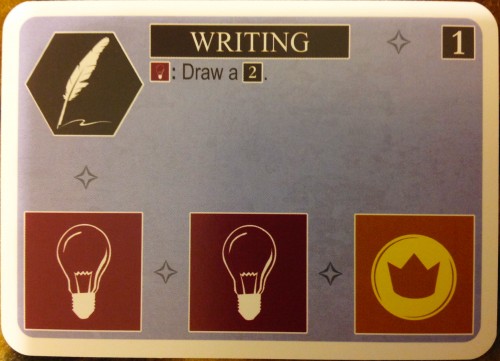 Let’s take another look at Writing, for example. It’s an Age 1, or Prehistoric, technology. During setup, stacks representing all 10 Ages of history, each holding roughly 10 cards, are arranged in order. All players begin in Age 1, and can only begin drawing cards from the later ages once the Age 1 draw pile is depleted or if they have melded (added to their tableau) a technology from a later age. Since cards from later ages are almost universally more valuable than earlier ones, this makes that simple Writing technology, whose only effect is “Draw a 2”, the key to unlocking a host of strategic choices for the lucky player who draws it early in the game. While the other players are stuck in the Stone Age, discovering important but rudimentary technologies like Sailing, Pottery and Domestication, you can be drawing Age 2 (Classical era) technologies such as Mapmaking, Currency and Mathematics.
Let’s take another look at Writing, for example. It’s an Age 1, or Prehistoric, technology. During setup, stacks representing all 10 Ages of history, each holding roughly 10 cards, are arranged in order. All players begin in Age 1, and can only begin drawing cards from the later ages once the Age 1 draw pile is depleted or if they have melded (added to their tableau) a technology from a later age. Since cards from later ages are almost universally more valuable than earlier ones, this makes that simple Writing technology, whose only effect is “Draw a 2”, the key to unlocking a host of strategic choices for the lucky player who draws it early in the game. While the other players are stuck in the Stone Age, discovering important but rudimentary technologies like Sailing, Pottery and Domestication, you can be drawing Age 2 (Classical era) technologies such as Mapmaking, Currency and Mathematics.
And once you have Mathematics in hand…oh, the places you’ll go then. Like Writing, Mathematics is a blue card with 2 bulb icons and 1 crown icon. Unlike Writing, it is an Age 2 technology, which means that as soon as it’s melded into your culture, you can draw from the Classical era’s suite of concepts even without Writing’s culture-advancing abilities. In fact, you couldn’t use Writing anymore if you wanted to; when you put Mathematic into play, you placed it on top of a stack of all other technologies of the same color you had previously discovered, burying them and making their dogma effect unusable. You could say that the advent of Mathematics pushed Writing out of the limelight. It’s still a part of your culture, but for now, its effects are dormant.
That doesn’t matter, though, because Mathematics’ dogma effect is even more powerful than Writing’s. It reads: “You may return a card from your hand. If you do, draw and meld a card of value one higher than the card you returned.” Again, this might not look like much at first. But let’s not forget the reason you melded Mathematics in the first place: you always get to draw from the age matching the highest-value card (determined by the card’s Age) in your culture. So you can use Mathematics to discard another Age 2 technology, like Monotheism (who needs religious mystery in the age of rationalism?) and replace it with something from Age 3 (the Medieval era)—say, Engineering. On your next turn, you can draw a new Medieval card, then immediately exchange it for something from Age 4, the Renaissance. And you can keep doing this to rocket through the ages, one turn at a time, discovering Banking and Refrigeration and Quantum Theory while your rivals are still puzzling out Road Building.
Tread cautiously, though. While early technologies are slow but stable, later technologies can be volatile. Even Writing, while it doesn’t provide the same rocket boost as Mathematics, has the advantage of being somewhat more contemplative and circumspect. With Mathematics, you must meld the card that you drew, even if it buries another technology you would rather have. Writing is slower, but it allows you to examine and judge for yourself exactly how and when to put your ideas into action.
But let’s return to our rocket-fueled tribe of mathematicians. Let’s say they’ve advanced all the way to Software [Blue/Age 10/Clock], which includes the dogma effect: draw and meld two 10s, executing the second card’s dogma effects automatically. Sounds great, right? But if one of the cards you draw is A.I. [Purple/Age 10/Bulb], it could end the game prematurely—one of A.I.’s dogma effects reads, “If Robotics and Software are top cards on any board, the single player with the lowest score wins.” In other words, if the machines become self-aware, the least developed civilization has the greatest chance of survival. That might not be you. As I said, tread carefully.
Which makes for a wonderful parable, especially in concert with the cultures evolving around you. While the mathematicians threw caution to the wind in their quest for discovery, another player may have been stolidly exploiting Metalworking, an Age 1 red technology with the tower icon. It reads: “Draw and reveal a 1. If it has a tower icon, score it and repeat this dogma effect. Otherwise, keep it.” “Scoring” a card means adding its value to your score pile, which will later allow you to “achieve”—outside of those volatile Information Age technologies, building up your score pile and achieving is the main path to winning the game. So this village of humble metalworkers picks slowly through the gestalt of Prehistory, extracting the value from the stone and keeping the rest for later use. Once the Age 1 draw pile is exhausted, they mine the Classical era, then the Medieval era, et cetera. It is less glamorous than the explosion of cultural development spurred by Mathematics, and will become impracticable in later ages when towers give way to factories—you might say that the age of mining has given way to the age of processing—but practical technologies like Metalworking are a solid path to early-era achievement.
What makes these disparate strategies so appealing is the way they overlap. In Innovation, what your rivals are doing can affect your own civilization profoundly, thanks to icons—the one aspect of the cards left to be explained. Just as, in history, it would be foolish to presume that there was only one culture in history capable of mathematics and only one culture capable of metalworking, there is seldom a single culture able to exploit these technologies in the game of Innovation. Once you have melded it, it is more or less a permanent part of your culture—after all, you’ve discovered it—but that doesn’t mean that only you can use it. Each dogma effect is preceded by one of the game’s 8 icons. Before the dogma effect is resolved, all players tally up all visible icons of that type in their tableau. Any players who have at least as many of that icon as the player who “owns” the card will also resolve the dogma effect—and they get to do it first. It makes perfect sense if you view the icons as your civilization’s resources (or, more accurately, knowledge of how to exploit those resources). Light bulbs, for instance, represent conceptual thinking, while leaves represent understanding of the natural world and crowns represent government and economics. If your neighbor to the north has developed Mathematics, but your civilization excels at abstract concepts, it only makes sense that you would stand to reap the rewards of their innovation.
Remember how Mathematics covered up Writing earlier? Well, some of the dogma effects allow you to “splay” a color of cards in a particular direction—that is, fan all cards of that color up, right or left. This means that icons (but not dogma effects) that were previously covered up become visible again. With Philosophy, for example, you may be able to reveal some previously buried icons, tapping into your civilization’s prior innovations to achieve dominance in the present technological landscape.
Of course, if a player is having trouble keeping up with the Joneses, they can always experiment with Fission, a Postmodern technology that has a roughly 1/5 chance of removing “all hands, boards and score piles” from the game—literally wiping every culture, including your own, from the face of the Earth. This tabula rasa leaves players with only their achievements, memories of what their civilization once was, and whatever equally volatile Postmodern and Information Age technologies remain to be exploited.
All of this is to say that Innovation is, despite its appearances, a highly thematic game—but in a way unlike nearly all other thematic board games out there. Usually, when a game sets out to tell a story and transport the player, it does it through evocative imagery, atmospheric flavor text, plastic miniatures and buckets of theme-appropriate terminology (“equip” or “summon” instead of “play,” for instance). Innovation uses a bare-bones visual aesthetic, unthematic terminology (“meld” is a term borrowed from Rummy), and a purposely opaque naming scheme to accomplish the same thing. Nowhere in the rules does it address what the colors and icons represent, because they don’t need to be addressed—their meaning comes clear naturally through play, through discovery. And the cards themselves are delightfully obscure in their thematic connotations, each a zen kōan waiting to be unlocked.
If you dig through the deck and pick out an individual card, like Industrialization [Red/Age 6/Factory]: “Draw and tuck [put into play below all other cards of its color] a 6 for every two factory icons on your board; you may splay your red or purple cards right,” you might scratch your head as to how the name and effect go together. But in play, you feel its effects on your culture, and they feel like industrialization, for better or worse. It’s emotive and performative, not allusive.
This makes Innovation, unexpectedly, a storytelling game and a poetic game. The poetry is in the obscurity of each of its 105 technologies, and the storytelling is in the delightful way they come together to evoke the history of an unnamed and unexpected (but often familiar) civilization. I cannot recommend it highly enough. Innovation has two expansions as well: Echoes of the Past and Figures in the Sand. The latter introduces historical figures, major and minor, into the mix, while Echoes focuses on bringing even more delightfully opaque technologies to play with (here, and throughout this review, I am using the word play to suggest a concept broader than simply competing to win the game). I will leave you with a few of them, to meditate on in your own quiet moments of play:
Loom [Red/Age 6/Factory]: Score your lowest top card. You may return two cards of different value from your score pile. If you do, draw and tuck three 6s.
Sliced Bread [Green/Age 8/Crown]: Return a card from your score pile. Draw and score two cards of value one less than the value of the card you returned.
Rock [Purple/Age 9/Leaf]: Another player must transfer their top green card to your hand. Then, if Scissors is their new top green card, you win. If not, you may score a top card from your board, and if Paper is your top green card, you win.
Human Genome [Blue/Age 10/Bulb]: You may draw and score a card of any value. Take a bottom card from your board into your hand. If the values of all the cards in your hand match the value of all the cards in your score pile exactly, you win.
***
Byron Alexander Campbell is a writer, editor and intermittent game critic. His fiction has appeared in Polluto, [out of nothing] and the Interactive Fiction Archive. Follow him at theyearisyesterday.
Tags: Byron Alexander Campbell, Carl Chudyk, innovation

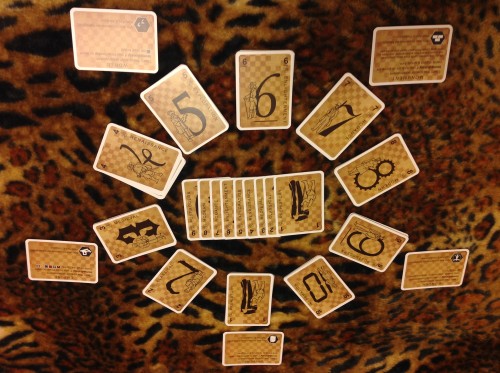
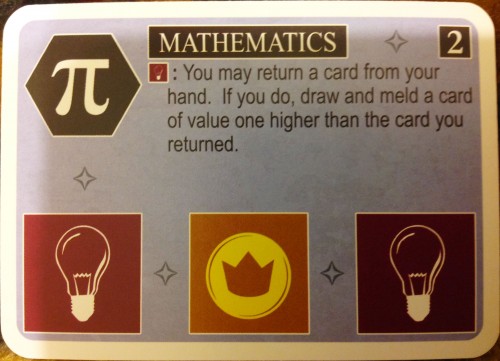

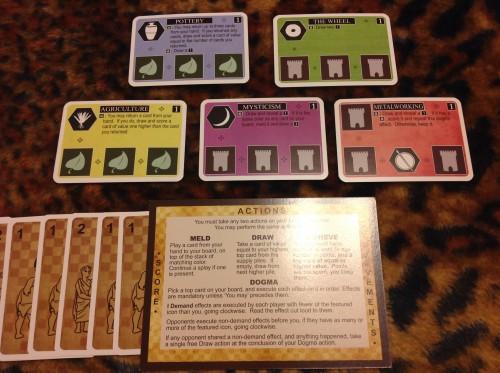
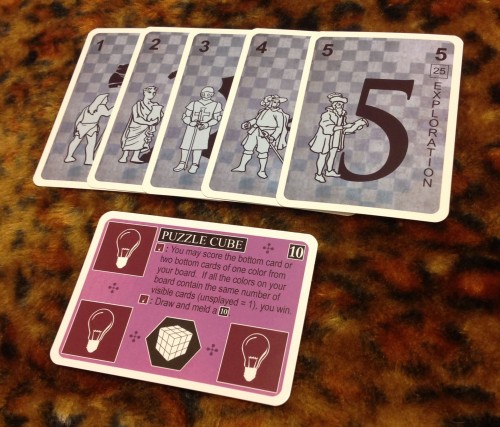
This looks AWESOME. Definitely ordering and looking forward to playing.
Played this a lot last year. Haven’t played in a long time. But reading this takes me back to the logic. Maybe I’ll play again someday. I don’t know.